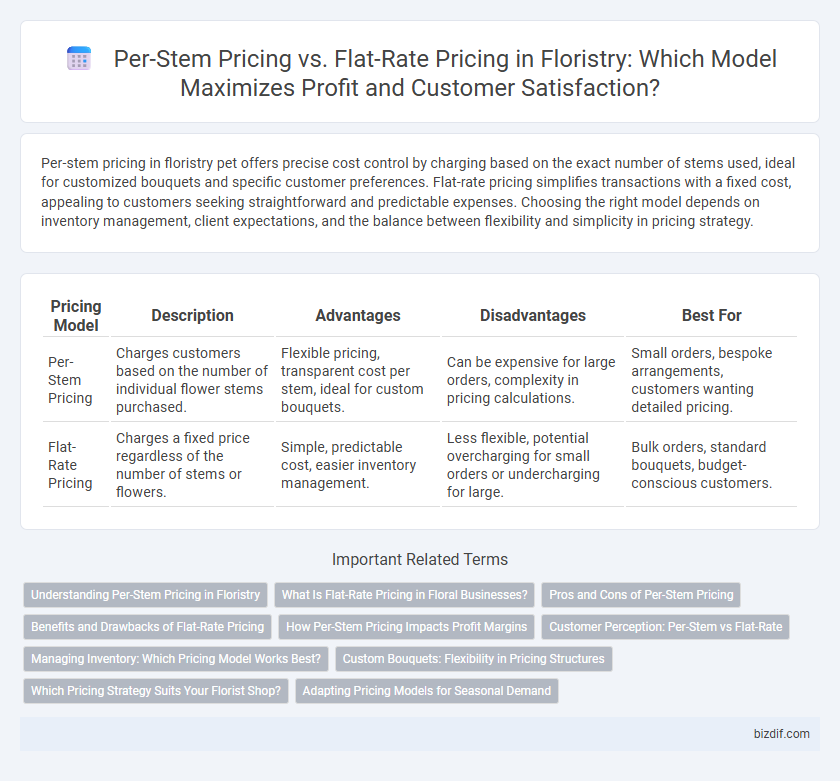Per-stem pricing in floristry pet offers precise cost control by charging based on the exact number of stems used, ideal for customized bouquets and specific customer preferences. Flat-rate pricing simplifies transactions with a fixed cost, appealing to customers seeking straightforward and predictable expenses. Choosing the right model depends on inventory management, client expectations, and the balance between flexibility and simplicity in pricing strategy.
Table of Comparison
| Pricing Model | Description | Advantages | Disadvantages | Best For |
|---|---|---|---|---|
| Per-Stem Pricing | Charges customers based on the number of individual flower stems purchased. | Flexible pricing, transparent cost per stem, ideal for custom bouquets. | Can be expensive for large orders, complexity in pricing calculations. | Small orders, bespoke arrangements, customers wanting detailed pricing. |
| Flat-Rate Pricing | Charges a fixed price regardless of the number of stems or flowers. | Simple, predictable cost, easier inventory management. | Less flexible, potential overcharging for small orders or undercharging for large. | Bulk orders, standard bouquets, budget-conscious customers. |
Understanding Per-Stem Pricing in Floristry
Per-stem pricing in floristry refers to charging customers based on the exact number of individual flowers or stems used in an arrangement, allowing precise cost calculation and customization. This pricing model offers transparency and flexibility, enabling customers to select flowers according to their budget and preferences while florists can accurately cover material costs. Unlike flat-rate pricing, per-stem pricing aligns the final cost with the quantity and type of blooms, ensuring fair pricing based on actual floral usage.
What Is Flat-Rate Pricing in Floral Businesses?
Flat-rate pricing in floral businesses involves charging a single, fixed price for an entire bouquet or arrangement regardless of the number of stems used. This pricing model simplifies the purchasing process for customers and helps florists manage costs and inventory more predictably. By offering a consistent price, florists can emphasize design quality and style rather than stem count.
Pros and Cons of Per-Stem Pricing
Per-stem pricing allows customers to pay based on the exact number of flowers chosen, providing flexibility and cost control for small or customized arrangements. This pricing method can result in higher costs for large bouquets and requires careful inventory management to maintain profitability. While it supports transparency and customization, per-stem pricing may complicate sales for florists compared to flat-rate pricing structures.
Benefits and Drawbacks of Flat-Rate Pricing
Flat-rate pricing in floristry offers simplicity and predictability, allowing customers to pay a fixed amount regardless of the number or variety of stems, which can streamline budgeting for events and easy ordering for beginners. However, this pricing model may lead to overpaying for smaller, simpler arrangements or undervaluing more complex, larger bouquets, potentially reducing profit margins for florists. While flat-rate pricing enhances transparency and convenience, it may also limit flexibility and fail to reflect the true cost differences between diverse floral designs.
How Per-Stem Pricing Impacts Profit Margins
Per-stem pricing allows florists to precisely allocate costs based on individual flower types, leading to more accurate profit margin calculations and minimizing losses from underpriced arrangements. This pricing strategy increases flexibility in managing inventory and responding to market demand fluctuations, directly enhancing overall profitability. Retailers leveraging per-stem pricing often experience improved cash flow and better control over cost structures compared to flat-rate pricing models.
Customer Perception: Per-Stem vs Flat-Rate
Customer perception of per-stem pricing often aligns with greater transparency and customization, allowing clients to pay specifically for the quantity and type of flowers chosen. Flat-rate pricing appeals to customers seeking simplicity and predictability, as it bundles services and flower costs into a single fee, which can enhance perceived convenience. Understanding these preferences helps florists tailor pricing strategies to meet expectations and improve satisfaction in floral service transactions.
Managing Inventory: Which Pricing Model Works Best?
Per-stem pricing offers precise cost control by charging customers based on the exact quantity of flowers purchased, simplifying inventory management through accurate stock tracking and minimization of waste. Flat-rate pricing streamlines sales processes but may lead to inventory challenges, such as overstocking or underpricing, especially when dealing with diverse flower varieties and fluctuating demand. Florists aiming for efficient inventory management and reduced loss typically benefit more from a per-stem pricing model, which aligns revenue with actual stock movement.
Custom Bouquets: Flexibility in Pricing Structures
Custom bouquets benefit from per-stem pricing by offering precise control over costs based on flower selection and quantity, accommodating varying budget sizes. Flat-rate pricing simplifies purchase decisions with a single, predictable price but may limit personalization and cost efficiency for unique designs. Florists balance these models to enhance customer satisfaction through tailored pricing that reflects bouquet complexity and preferences.
Which Pricing Strategy Suits Your Florist Shop?
Per-stem pricing offers flexibility and transparency, ideal for bespoke arrangements and customers seeking specific flower quantities, while flat-rate pricing simplifies purchasing with bundled bouquets, attracting clients who prefer convenience and fixed costs. Shops specializing in custom, event-driven designs benefit from per-stem pricing to accurately reflect the value of rare or seasonal blooms, whereas retail stores with high volume sales and pre-made arrangements may find flat-rate pricing more efficient for inventory management. Evaluating customer preferences, operational capacity, and flower variety determines which pricing strategy best optimizes profitability and customer satisfaction in your florist shop.
Adapting Pricing Models for Seasonal Demand
Adjusting floristry pricing models to seasonal demand involves balancing per-stem pricing and flat-rate pricing strategies to optimize revenue. Per-stem pricing allows precise cost control during high-demand seasons, reflecting the fluctuating prices of flowers and materials. Flat-rate pricing simplifies customer decisions during off-peak periods while maintaining profit margins through bundled floral arrangements.
Per-Stem Pricing vs Flat-Rate Pricing Infographic

 bizdif.com
bizdif.com